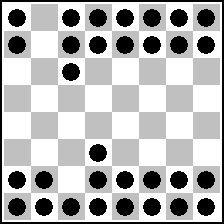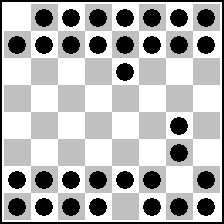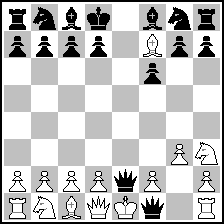
Website founded by
Milan Velimirović
in 2006
1:36 UTC


| |
MatPlus.Net  Forum Forum  General General  Tacu's Enigma Tacu's Enigma |
| |
|
|
|
|
You can only view this page!
| | Page: [Previous] [Next] 1 2 | | (1) Posted by Kevin Begley [Thursday, Jun 30, 2022 00:16] | Tacu's Enigma
Has anyone compiled a list of "Tacu's Enigma" problems? (link?)
I thought I'd contribute the following, if not anticipated:
KB
MPForum, 2022
 (= 0+31 ) (= 0+31 )
PG4 White is checkmated
Circe ContraParrain
I will not include the solution (in case somebody wants to solve), but the intent can be found with the following Jacobi input:
Stipulation PG 4.0
forsyth X1XXXXXX/X1XXXXXX/2X5/8/8/3X4/XX1XXXXX/XXXXXXXX
ColorThePieces
Test #
Condition Circe ContraParrain
| | | (2) Posted by Hauke Reddmann [Thursday, Jun 30, 2022 08:51] |
*Some* (not *the* link):
https://www.thbrand.de/tag/tacu-enigma/
(German, obviously)
| | | (3) Posted by Kevin Begley [Thursday, Jun 30, 2022 10:03] |
Thank you, Hauke.
| | | (4) Posted by Kevin Begley [Thursday, Jun 30, 2022 12:07] |
Here's another:
KB
MPForum, 2022
 (= 0+31 ) (= 0+31 )
PG5 White is checkmated
Circe Equipollent
Solution not provided (in case somebody wants to solve), but the intent can be found with the following Jacobi input:
Stipulation PG 5.0
forsyth XXX1XXXX/XXX1XXXX/8/8/6X1/1XX5/XX1XXXXX/XX1XXXXX
ColorThePieces
Test #
Condition Circe Equipollent
| | | (5) Posted by Kevin Begley [Friday, Jul 1, 2022 02:00] |
Last one (I promise):
KB
MPForum, 2022
 (= 0+31 ) (= 0+31 )
PG5 White is checkmated
Circe Parrain
Solution not provided (in case somebody wants to solve), but the intent can be found with the following Jacobi input:
Stipulation PG 5
forsyth XXXX1XXX/XXXX1XXX/5X2/8/8/6XX/XXXXXX1X/XXXXXX1X
ColorThePieces
Test #
Condition Circe Parrain
| | | (6) Posted by Per Olin [Friday, Jul 1, 2022 09:13] |
Per Olin
Quartz 25 JT
2nd Commendation
Award: Quartz 54 February 2022 p. 915
 (= 0+32 ) (= 0+32 )
PG 3.0 Chess960 32 undefined pieces
Try to make it shorter with any condition! - Solution in a couple of days.
Solution added July 3rd: QRKNRNBB 1.g4 Nde6 2.Ng3 O-O-O 3.Rf1 Qb8 C+ Jakobi
| | | (7) Posted by Joost de Heer [Friday, Jul 1, 2022 10:35] |
https://quartz.chessproblems.ca/
Quartz 43 and 44 contain several Tacu's Enigma's.
| | | (8) Posted by Kevin Begley [Friday, Jul 1, 2022 10:37] |
@Per,
I happened upon your problem just a few hours before you posted it. Very impressive!!
What do you mean make one shorter?
You mean fewer moves (than 3.0)? In any condition?
That doesn't seem a challenge (I must be misreading you), but OK, just in case, I will break my promise for a PG2.5...
 (= 0+32 ) (= 0+32 )
PG2.5 Black is checkmated
Circe Contra Parrain
1.d3 f6 2.Bh6 gxh6 3.Qd2 [+wBh5]#
[EDIT: I am now guessing you must have meant: make a shorter PG, in any condition, absent secondary goals (e.g., black is checkmated), where all 32 units are fully identified in the solution. If that's correct, I'll need to think about that challenge (after you state the challenge clearly) -- but, I would note that chess960 is not really 32 unidentified units. A shuffle variant, by contrast, would be closer to fully unidentified, but even then, the randomness tends only to apply to the back ranks (whereas, units on the 2nd- and 7th-rank start as pawns).]
| | | (9) Posted by Per Olin [Friday, Jul 1, 2022 11:14] |
After seeing the examples in post 7 by Joost, my wish for shorter ones is fulfilled; I was speaking in general for any type of conditions. I am fairly confident that it can not be not be done shorter than 3.0 moves in Chess960 with no further information than the locations of the pieces. There is a difference in the level of information given in e.g. ‘PG 4.5’, ‘PG 4.5 and Black is checkmated’ and ‘PG 4.0 & 1#’; the first one gives least information.
| | | (10) Posted by Kevin Begley [Friday, Jul 1, 2022 11:28] |
Thank you for clarifying.
As noted previously (in the edited section of my post above) I wouldn't consider chess960 a full shuffle, however (it is certainly the most popular shuffle variant, and a very interesting condition when well exploited -- as you have impressively demonstrated in your problem -- but still, hardly a full shuffle).
Can you extend your problem to a fully random shuffle of the back rank (with or without symmetry in the shuffle)?
In these cases, how many moves would be needed to fully resolve the nature and color of all units (and determine the game)?
And, what if we extend the random shuffle to the logical extreme.
Suppose 32 units are dropped (ANYWHERE) on the board at the start, with the only rules being:
1) No player stands in check,
2) No player is stalemated, and
3) Pawns may not land on the 1st or the 8th ranks.
How many moves will be needed to identify both the nature and color of every unit on the board (given only the final position)?
Is this even possible from just a final diagram? Maybe if you end with a very specific position, and the fastest A=>B problem possible happens to be unique (not easy).
Suppose you provide:
1) the initial position (showing only undefined units/colors -- after all, this is implicitly provided in any PG),
2) the final diagram (again, all undefined units/colors), and
3) the number of moves for an A=>B stipulation?
a) with or without extraneous stipulations (such as "White is checkmated").
b) with or without extraneous conditions (note: I must insist that Reflexmate counts as both an extraneous fairy condition plus an extraneous selfmate stipulation, despite an ongoing history of erroneous classification).
I wonder: how many moves would be needed to define the nature and color of every unit, and every move made, in the course of the solution?
| | | (11) Posted by Kevin Begley [Saturday, Jul 2, 2022 01:06] |
Can anyone please share a good way to search for such problems in any (and all) problem databases (PDB, YACPDB, and WinChloe)?
| | | (12) Posted by Per Olin [Saturday, Jul 2, 2022 09:59] |
Interesting questions in post 10, not easy to estimate what is possible and what is not. Clarification of definitions as I understand them: Chess960 shuffle has limitations for the placement of rooks in relation to king and requires bishops on squares of different colour; full random shuffle has not these restrictions.
----------------------------
Can you extend your problem to a fully random shuffle of the back rank (with or without symmetry in the shuffle)?
In these cases, how many moves would be needed to fully resolve the nature and color of all units (and determine the game)?
Answer PO: Without computer aid most probably impossible; my impression is that neither Jakobi nor any other testing program can assist.
--------------------------------------
And, what if we extend the random shuffle to the logical extreme.
Suppose 32 units are dropped (ANYWHERE) on the board at the start, with the only rules being:
1) No player stands in check,
2) No player is stalemated, and
3) Pawns may not land on the 1st or the 8th ranks.
How many moves will be needed to identify both the nature and color of every unit on the board (given only the final position)?
Is this even possible from just a final diagram? Maybe if you end with a very specific position, and the fastest A=>B problem possible happens to be unique (not easy).
Answer PO: Reminds me of a research presented in Retro corner, where was given an estimate for all possible legal positions. The number is extremely high, not possible to grasp for us who are not used to count beyond 64. Systemizing how to attack all these positions in a sensible way might be a challenging exercise for mathematicians and computer science.
-------------------------------------------
Suppose you provide:
1) the initial position (showing only undefined units/colors -- after all, this is implicitly provided in any PG),
2) the final diagram (again, all undefined units/colors), and
3) the number of moves for an A=>B stipulation?
a) with or without extraneous stipulations (such as "White is checkmated").
b) with or without extraneous conditions (note: I must insist that Reflexmate counts as both an extraneous fairy condition plus an extraneous selfmate stipulation, despite an ongoing history of erroneous classification).
I wonder: how many moves would be needed to define the nature and color of every unit, and every move made, in the course of the solution?
Answer PO: This must be dependent on the number of pieces. Supposing all pieces move, if we have 3+3 pieces in both A and B, then it must be a smaller number of moves needed to identify the pieces than with 12+12 pieces. If Jakobi supports testing (!?), then it might well be worth giving it a try.
| | | (13) Posted by Hauke Reddmann [Saturday, Jul 2, 2022 20:47] |
@Kevin: Extremely interesting question!
Assume orthodox chess. 1.O-O O-O-O identifies 4 pieces including colors,
then add 14 knight moves on both sides, and all pieces are identified
in 15 moves. This can be brought down somewhat: wXg4xh2 shows h2 is
a bR, otherwise castling would be illegal. Three pieces of each color
can determined this way, thus my first "record" is 24 plies to
identify all pieces.
| | | (14) Posted by Kevin Begley [Sunday, Jul 3, 2022 02:13] |
@Hauke,
How do you castle in a shuffle variant?
How can I have created a monster, when I don't yet comprehend its animation?
I am assuming you intend to begin from the most favorable drop, whereby castling is legal.
Yes, of course -- you must be on the right track, here.
But, how can 14 knight moves... unless you are aiming for a massacre PG!? GASP!
You left the bodies unidentified, didn't ya, and you only moved the Knights!?
You only moved the headstones!!
Why? WHY!!!?
OK. That might just be crazy enough to work. :)
| | | (15) Posted by Hauke Reddmann [Sunday, Jul 3, 2022 17:13] |
@Kevin: I am an "ortho" man and thus began with the
simplest question: How many moves are maximally needed
to identify 32 unknown pieces in an ideal legal orthodox
position?
You can now complicate at will :-)
For example, 960 allows a very long castling and thus
much more unknowns to be identified as pawns. The only
thing I can say about shuffling chess - if I suspect the
rules correctly - is the following: If no castling...
1 ply to identify each of 10 knights
2 ply to identify Q and K
1 ply to identify RR and BB (by exclusion)
...meaning 2*18 plies suffice to identify an ideal
position (assuming White has the move and the colors
are identified by moving). I bet by illegal check exclusion
the RRBB plies may be shaved.
I admit having not the slightest idea about the absolute
minimum in shuffle chess.
| | | (16) Posted by seetharaman kalyan [Sunday, Jul 3, 2022 20:23] |
Can you please post the solutions to the problems 1,4,5,6?
| | | (17) Posted by Kevin Begley [Sunday, Jul 3, 2022 22:34] |
Problem 1 (Circe ContraParrain):
1.c4 Sc6 2.c5 Sd4 3.c6 Sxe2 4.Sxe2 [+wPg1] bxc6 [+bSd3]#
 (= 15+16 ) (= 15+16 )
Problem 4 (Circe Equipollent):
1.c3 d5 2.Qa4+ Qd7 3.b3 d4 4.Qxd4 [+bPg4] Qxd4 [+wQd1] 5.Bb2 Qxf2#
 (= 15+16 ) (= 15+16 )
Problem 5 (Circe Parrain):
1.g3 e6 2.Bh3 Ke7 3.Bxe6 Qe8 [+bPf6] 4.Sh3 Kd8 5.Bxf7 Qxe2 [+bPf1=Q]#
 (= 15+16 ) (= 15+16 )
| | | (18) Posted by Kevin Begley [Sunday, Jul 3, 2022 23:10] |
@Hauke,
Isn't the proper question: What are the minimal number of moves needed to identify 32 unknown units (whether in an ideal legal orthodox position, or otherwise)?
In Chess960, for example, the starting position, the final position, and a unique game can be identified with just 3.0 choice moves from a smartly selected starting position (as demonstrated by Per Olin).
He suggests this can not be done in fewer than 3.0 moves. Having failed to find a faster example, I am inclined to agree.
Theoretically, it becomes easier if you allow more moves, up to some point (when you come to the wicked bend at the end of easy street).
Whether a maximal number of moves exists is another question entirely.
And if a maximal number of moves does theoretically exist, finding that is yet another matter.
You have inverted the question.
Instead of asking "How Many Licks Does It Take To Get To A Tootsie Pop's Center?", you ask us to consider the maximal number of licks before exposing the Tootsie Core.
So, you're hunting for a position, from the longest game possible, wherein the location of stones can not be reached in fewer moves.
That is, indeed, a very interesting question!
I am anxious to see the specific problem you might propose (for legal orthodox positions, or otherwise).
You have tested this with Jacobi?
| | | (19) Posted by Hauke Reddmann [Monday, Jul 4, 2022 08:24] |
No, did no testing (specifically as I haven't proposed a position yet - no time :-)
Yes, I kind of inverted the question, since the maximally undetermined
approach (just give 32 dots with no a priori information at all)
may easier bounded from above first.
| | | (20) Posted by Per Olin [Monday, Jul 4, 2022 20:26] |
What is the minimal number of moves needed to identify 32 unknown units with ideally placed pieces? What is the maximum number of moves needed to identify 32 unknown units in the most unfavourable case? Answering the latter question needs quite a project, so my contribution will be to try to analyse the first one.
In the area of a=>b-problems with undefined pieces, Jakobi informs that no undefined pieces are allowed in the initial position of an a=>b-test. Therefore, for testing purposes the pieces have been identified; a human check for the correctness is additionally needed.
A
 (= 0+32 ) (= 0+32 )
B
 (= 0+32 ) (= 0+32 )
A=>B 6.0 moves 16 + 16 undefined pieces
Solution with defined pieces can be seen from
forsyth rsb1k2r/5R1p/p2p1bps/Bpp1p1P1/3P4/P3Pp2/BPP1SP1P/QqS1K2R
stip a=>b6.0 forsyth 2krr1s1/1R1s3p/p2pBbp1/1pp1p1P1/3P4/PS2Pp1b/1PP2P1P/Q1SqBRK1
with play 1.O-O Bh3 2.Rb7 Nd7 3.Be1 O-O-O 4.Be6 Rhe8 5.Nb3 Qd1 6.Nec1 Ng8
There seems to be several possibilities for stipulation / solution:
1) With diagram A only
Stipulation: Minimum number of moves to identify all pieces Solution: 6 moves, e.g. by play 1.O-O Bh3 2.Rb7 Nd7 3.Be1 O-O-O 4.Be6 Rhe8 5.Nb3 Qd1 6.Nec1 Ng8; in this case the moves are not unique, e.g. the wBa2 can land on several squares; the uniqueness is got by asking the number of moves, which is exact.
2) With both diagrams
Stipulation: A=>B 6.0 Solution 1.O-O Bh3 2.Rb7 Nd7 3.Be1 O-O-O 4.Be6 Rhe8 5.Nb3 Qd1 (in both cases it will be useful to indicate also the starting square of a move, e.g. Bc8-h3)
Remarks:
- A black rook can not reach the SW corner without destroying the white castling right
- There are no captures, on every line there is a white pawn below a black pawn
- Nature of officers on a1 and f6 determined without these pieces moving. This must be a crucial matter in this exercise: how many pieces can be identified without moving on retroanalytical grounds, by exclusion etc.?
If this happens to be correct, then the question is how much shorter can this be done.
| |
Read more... | Page: [Previous] [Next] 1 2
MatPlus.Net  Forum Forum  General General  Tacu's Enigma Tacu's Enigma |
|
|
|
 ISC 2025
ISC 2025 Forum
Forum  General
General  Tacu's Enigma
Tacu's Enigma 


